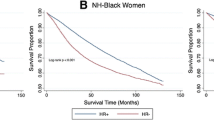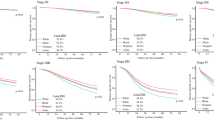Abstract
Background
African American (AA) women with breast cancer have persistently higher mortality compared to whites. We evaluated racial disparities in mortality among women with estrogen receptor (ER)/progesterone receptor (PR)-negative breast cancer.
Methods
The study population included 542 women (45% AA) diagnosed with ER/PR-negative Stage I through III breast cancer treated at the Henry Ford Health System (HFHS) between 1996 and 2005. Linked datasets from HFHS, Metropolitan Detroit Cancer Surveillance System, and the U.S. Census Bureau were used to obtain demographic, socioeconomic, and clinical information. Economic deprivation was categorized using a previously validated deprivation index, which included 5 categories based on the quintile of census tract socioeconomic deprivation. Cox proportional hazards models were used to assess the relationship between race and mortality.
Results
AA women were more likely to have larger tumors, have higher Charlson Comorbidity Indices (CCI), and to reside in economically deprived areas. In an unadjusted analysis, AA women demonstrated a significantly higher risk of death compared to whites [hazard ratio (HR) 1.47, 95% confidence interval (CI) 1.09–2.00]. Following adjustment for clinical factors (age, stage, CCI) and treatment (radiation and chemotherapy), AA race continued to have a significant impact on mortality (HR 1.51, CI 1.10–2.08 and HR 1.63, CI 1.20–2.21). Only after adjusting for deprivation was race no longer significant (HR 1.26, CI 0.84–1.87).
Conclusions
Social determinants of health play a large role in explaining racial disparities in breast cancer outcomes, especially among women with aggressive subtypes.
Similar content being viewed by others
References
Wheeler SB, Reeder-Hayes KE, Carey LA (2013) Disparities in breast cancer treatment and outcomes: biological, social, and health system determinants and opportunities for research. Oncologist 18:986–993
Barcenas CH, Wells J, Chong D, French J, Looney SW, Samuel TA (2010) Race as an independent risk factor for breast cancer survival: breast cancer outcomes from the medical college of georgia tumor registry. Clin Breast Cancer 10:59–63
Ademuyiwa FO, Edge SB, Erwin DO, Orom H, Ambrosone CB, Underwood W III (2011) Breast cancer racial disparities: unanswered questions. Cancer Res 71:640–644
Chlebowski RT, Chen Z, Anderson GL et al (2005) Ethnicity and breast cancer: factors influencing differences in incidence and outcome. J Natl Cancer Inst 97:439–448
Vona-Davis L, Rose DP (2009) The influence of socioeconomic disparities on breast cancer tumor biology and prognosis: a review. J Womens Health 18:883–893
Lund MJ, Trivers KF, Porter PL et al (2009) Race and triple negative threats to breast cancer survival: a population-based study in Atlanta, GA. Breast Cancer Res Treat 113:357–370
Gapstur SM, Dupuis J, Gann P, Collila S, Winchester DP (1996) Hormone receptor status of breast tumors in black, Hispanic, and non-Hispanic white women. An analysis of 13,239 cases, GA. Cancer 77:1465–1471
Carey LA, Perou CM, Livasy CA et al (2006) Race, breast cancer subtypes, and survival in the Carolina Breast Cancer Study. JAMA 295:2492–2502
Parise CA, Bauer KR, Brown MM, Caggiano V (2009) Breast cancer subtypes as defined by the estrogen receptor (ER), progesterone receptor (PR), and the human epidermal growth factor receptor 2 (HER2) among women with invasive breast cancer in California, 1999–2004. Breast J 15:593–602
Chen VW, Correa P, Kurman RJ et al (1994) Histological characteristics of breast carcinoma in blacks and whites. Cancer Epidemiol Biomark Prev 3:127–135
Bauer KR, Brown M, Cress RD, Parise CA, Caggiano V (2007) Descriptive analysis of estrogen receptor (ER)-negative, progesterone receptor (PR)-negative, and HER2-negative invasive breast cancer, the so-called triple-negative phenotype: a population-based study from the California cancer registry. Cancer 109:1721–1728
Dignam JJ, Dukic V, Anderson SJ, Mamounas EP, Wickerham DL, Wolmark N (2009) Hazard of recurrence and adjuvant treatment effects over time in lymph node-negative breast cancer. Breast Cancer Res Treat 116:595–602
Cleator S, Heller W, Coombes RC (2007) Triple-negative breast cancer: therapeutic options. Lancet Oncol 8:235–244
Warner ET, Tamimi RM, Hughes ME et al (2015) Racial and ethnic differences in breast cancer survival: mediating effect of tumor characteristics and sociodemographic and treatment factors. J Clin Oncol 33:2254–2261
Albain KS, Unger JM, Crowley JJ, Coltman CA Jr, Hershman DL (2009) Racial disparities in cancer survival among randomized clinical trials patients of the Southwest Oncology Group. J Natl Cancer Inst 101:984–992
Simon MS, Severson RK (1997) Racial differences in breast cancer survival: the interaction of socioeconomic status and tumor biology. Am J Obstet Gynecol 176:S233–S239
O’Malley CD, Le GM, Glaser SL, Shema SJ, West DW (2003) Socioeconomic status and breast carcinoma survival in four racial/ethnic groups: a population-based study. Cancer 97:1303–1311
Newman LA, Mason J, Cote D et al (2002) African-American ethnicity, socioeconomic status, and breast cancer survival: a meta-analysis of 14 studies involving over 10,000 African–American and 40,000 White American patients with carcinoma of the breast. Cancer 94:2844–2854
Shavers VL, Harlan LC, Stevens JL (2003) Racial/ethnic variation in clinical presentation, treatment, and survival among breast cancer patients under age 35. Cancer 97:134–147
Crowe JP Jr, Patrick RJ, Rybicki LA, Grundfest-Broniatowski S, Kim JA, Lee KB (2005) Race is a fundamental prognostic indicator for 2325 northeastern Ohio women with infiltrating breast cancer. Breast J 11:124–128
Grann V, Troxel AB, Zojwalla N, Hershman D, Glied SA, Jacobson JS (2005) Regional and racial disparities in breast cancer-specific mortality. Soc Sci Med 62:337–347
Niu X, Pawlish KS, Roche LM (2010) Cancer survival disparities by race/ethnicity and socioeconomic status in New Jersey. J Health Care Poor Underserved 21:144–160
Warner ET, Gomez SL (2010) Impact of neighborhood racial composition and metropolitan residential segregation on disparities in breast cancer stage at diagnosis and survival between black and white women in California. J Community Health 35:398–408
Du XL, Lin CC, Johnson NJ, Altekruse S (2011) Effects of individual-level socioeconomic factors on racial disparities in cancer treatment and survival: findings from the National Longitudinal Mortality Study, 1979–2003. Cancer 117:3242–3251
Tian N, Wilson JG, Zhan FB (2011) Spatial association of racial/ethnic disparities between late-stage diagnosis and mortality for female breast cancer: where to intervene? Int J Health Geogr 10:24
Markossian TW, Hines RB, Bayakly R (2014) Geographic and racial disparities in breast cancer-related outcomes in Georgia. Health Serv Res 49:481–501
Akinyemiju TF, Soliman AS, Johnson NJ et al (2013) Individual and neighborhood socioeconomic status and healthcare resources in relation to black-white breast cancer survival disparities. J. Cancer Epidemiol 2013:490472
Du XL, Fang S, Meyer TE (2008) Impact of treatment and socioeconomic status on racial disparities in survival among older women with breast cancer. Am J Clin Oncol 31:125–132
Bradley CJ, Given CW, Roberts C (2002) Race, socioeconomic status, and breast cancer treatment and survival. J Natl Cancer Inst 94:490–496
Cross CK, Harris J, Recht A (2002) Race, socioeconomic status, and breast carcinoma in the US: what have we learned from clinical studies. Cancer 95:1988–1999
El-Tamer MB, Homel P, Wait RB (1999) Is race a poor prognostic factor in breast cancer? J Am Coll Surg 189:41–45
Yood MU, Johnson CC, Blount A et al (1999) Race and differences in breast cancer survival in a managed care population. J Natl Cancer Inst 91:1487–1491
Perkins P, Cooksley CD, Cox JD (1996) Breast cancer. Is ethnicity an independent prognostic factor for survival? Cancer 78:1241–1247
Ansell D, Whitman S, Lipton R, Cooper R (1993) Race, income, and survival from breast cancer at two public hospitals. Cancer 72:2974–2978
Bassett MT, Krieger N (1986) Social class and black-white differences in breast cancer survival. Am J Public Health 76:1400–1403
Roseland ME, Pressler ME, Lamerato LE et al (2015) Racial differences in breast cancer survival in a large urban integrated health system. Cancer 121:3668–3675
Parise CA, Caggiano V (2015) The influence of socioeconomic status on racial/ethnic disparities among the ER/PR/HER2 breast cancer subtypes. J. Cancer Epidemiol 2015:813456
Simon MS, Lamerato L, Krajenta R et al (2012) Racial differences in the use of adjuvant chemotherapy for breast cancer in a large urban integrated health system. Int J Breast Cancer 2012:453985
Charlson ME, Pompei P, Ales KL, MacKenzie CR (1987) A new method of classifying prognostic comorbidity in longitudinal studies: development and validation. J Chronic Dis 40:373–383
Deyo RA, Cherkin DC, Ciol MA (1992) Adapting a clinical comorbidity index for use with ICD-9-CM administrative databases. J Clin Epidemiol 45:613–619
Singh GK (2003) Area deprivation and widening inequalities in US mortality, 1969–1998. Am J Public Health 93:1137–1143
Wolff AC, Hammond ME, Schwartz JN et al (2007) American Society of Clinical Oncology/College of American Pathologists guideline recommendations for human epidermal growth factor receptor 2 testing in breast cancer. Arch Pathol Lab Med 131:18–43
Lund MJ, Butler EN, Hair BY et al (2010) Age/race differences in HER2 testing and in incidence rates for breast cancer triple subtypes: a population-based study and first report. Cancer 116:2549–2559
Acknowledgements
This study was funded in part by National Cancer Institute, N01-PC- 35145 (addendum 12) and the Wayne State University Clinical and Translational Science Pilot Program.
Author information
Authors and Affiliations
Corresponding author
Ethics declarations
Conflicts of interest
There are no conflicts of interest claimed by any of the authors.
Rights and permissions
About this article
Cite this article
Roseland, M.E., Schwartz, K., Ruterbusch, J.J. et al. Influence of clinical, societal, and treatment variables on racial differences in ER−/PR− breast cancer survival. Breast Cancer Res Treat 165, 163–168 (2017). https://doi.org/10.1007/s10549-017-4300-y
Received:
Accepted:
Published:
Issue Date:
DOI: https://doi.org/10.1007/s10549-017-4300-y




